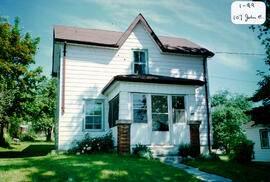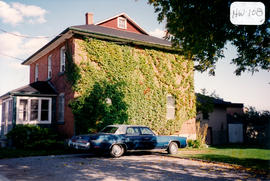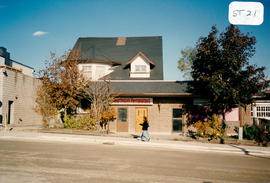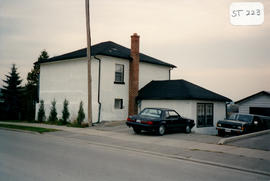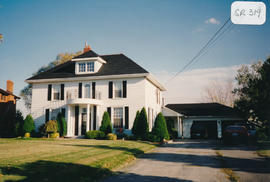The mid-block building on the north side at 107 John St. East was built around the 1880’s in the Gothic Revival Cottage style. The main house was moved to this site from the saw mill in Amsterdam during the early 1900’s. It was the home of Arthur “Mike” Saint and his wife Alice and children (Russell, Eric, Ralph, Zella, Rita and Archie). He had immigrated to Bradford from London, England in 1871 with his parents (William and Sarah) and siblings (Thomas, Harry, Frank, George, Annie and Maria). William died in 1875. All of his sons were in the building trade. Mike was a well-known brick layer and he also raised and showed chickens. There once was a 1½-storey frame barn at the back of the house that was used to store feed, a horse, and a cow. A chicken house was attached to the barn. A huge, old well was found (beyond the back fence) that was thought to belong to the first hotel (located on the only street) when Bradford was first founded.
The 1½-storey, three-bay house has a rectangular plan, a centre hall, a symmetrical façade with a centre gable over the entrance, and a medium-pitched, gable roof. A porch with a hip roof supported on wood posts and brick pedestals was added after the building was relocated. The enclosed porch was open originally, with only the brick pedestals remaining visible. Small windows have high floor to ceiling heights. Double-hung windows are set into rectangular openings with plain, wood frames and sills. The 2/2 windows are original. Wood frame construction is covered with vinyl siding and there is a parged, stone foundation. Originally, the cladding was stucco. According to the 2000 inventory, the building’s form is unmistakable despite the new cladding. (1, 2, 3)
Barn
41 Archival description results for Barn
The two-storey, brick house located at 108 Holland St. West was built by John Maurino on what was originally a 100-acre farm owned by John Skinner. Skinner lived on Church St. (at the southeast corner of John Street). There was a creek behind the original barn and a pond used for watering stock, etc. It was also used as a hockey and skating rink in the winter many years ago. The land was eventually sold to John Maurino. He added a two-storey shed and a new barn to the property at the time he built the house that is seen in this photo from 1995. Maurino and his wife (a sister of Cavallo, the local harness and shoemaker) farmed the land with their children Augustus, Aida, Frank, Lena and Laura. (1, 2)
George JacksonThis house is located at 187 John St. West (on the northwest corner of John and Toronto Streets). The 1½-storey, frame building was originally clad in stucco and it had a kitchen and rooms upstairs at the rear. There was also a garden and lawn at the back of the house. George Mapes and daughter Ella (wife of Jack Gapp), Curly Madian (?) and their daughters (Vivian and Margaret) lived here at one time. George was a retired farmer, dealer, and buyer. Years later, carpenter Joe LeBlanc and his family bought the house. He remodeled it and built a porch on the east side of the kitchen. Originally, there was a long barn (with a frame loft above) at the rear of the property. Joe’s daughter eventually had a nursing home built where the barn had stood. (1, 2)
George JacksonThe two-storey house located at 21 Simcoe Road was built by George Stoddart before World War I. Originally, it was clad in brick and there was a large barn at the rear across the full lot. There was also a 2’-square dumb waiter in the house. It was operated by a pulley system and used to move things from the basement to the upper floors. Mrs. Stoddart and her son (George) lived here for many years. Tom Bell retired from the Bank of Commerce in the 1930’s, and he and his wife and daughter (Dorothy) were next to live in this house. Dorothy lived here until her father died and she was too old to remain. (1, 2)
George JacksonThe Queen’s Hotel (located at 22 Holland St. West) was built circa 1850, and was originally the Western Hotel. This photo (taken in the fall of 1995) shows the structure just before a major renovation. The hotel went “dry” during World War I. Bradford, like all of Ontario, was experiencing prohibition (even though Bradford had voted “wet”). The building originally had two storeys. A third floor and a flat roof were added later. It was heated with an old steam engine that had the undercarriage removed. The engine first burnt 4’ stacks of hardwood, then coal, and finally, oil. Eventually a new furnace was installed (most likely natural gas). The building was always warm and thought of as a home away from home.
Harry Lang, Celina and their children (Evelyn, George and Audrey) moved here from North Bay and bought the building in the 1920’s. They ran the Temperance House, and a board and dining service at this location. They had long-time help and boarders. Little John Cook ran a shop selling ice cream, chocolate bars, and smokes on the east side (down one step). A bus stop was added when bus service started. Len and Art Saint put a cement addition on the back of the building around 1938. At the rear, there was a chicken house, a roofed, open shed, and a laneway. Another shed ran south, and to the west was an ice house. There was open space to the north before the laneway and a barn for hay and horses. The barn had two stories and below there was a pig sty. North of the laneway there was another open shed, car storage, and a cooking kitchen on the back of the hotel (a little east of the back entrance). Jack Wilson worked for Harry Lang for many years. Mitch Hepburn brought in beer in 1934 and the building opened as the Queen’s Hotel. Businessmen had to chip in to buy a liquor license and Hepburn was the first supplier. Business was excellent and the hotel was really crowded. Before the arrival of the beer, the locals had used it as a place to play dominoes and checkers, and to conduct hunt camp and other organizations’ meetings. (1, 2, 4)
The Queen’s Hotel (located at 22 Holland St. West) was built circa 1850. This photo (taken in the fall of 1995) shows the structure just before a major renovation. The hotel went “dry” during WWI. Bradford, like all of Ontario, was experiencing prohibition (even though Bradford had voted “wet”). The building originally had two storeys. A third floor and a flat roof were added later. It was heated with an old steam engine that had the undercarriage removed. The engine first burnt 4’ stacks of hardwood, then coal, and finally, oil. Eventually a new furnace was installed (most likely natural gas). The building was always warm and thought of as a home away from home.
Harry Lang, Celina and their children (Evelyn, George and Audrey) moved here from North Bay and bought the building in the 1920’s. They ran the Temperance House, and a board and dining service at this location. They had long-time help and boarders. Little John Cook ran a shop selling ice cream, chocolate bars, and smokes on the east side (down one step). A bus stop was added when bus service started. Len and Art Saint put a cement addition on the back of the building around 1938. At the rear, there was a chicken house, a roofed, open shed, and a laneway. Another shed ran south, and to the west was an ice house. There was open space to the north before the laneway and a barn for hay and horses. The barn had two stories and below there was a pig sty. North of the laneway there was another open shed, car storage, and a cooking kitchen on the back of the hotel (a little east of the back entrance). Jack Wilson worked for Harry Lang for many years. Mitch Hepburn brought in beer in 1934 and the building opened as the Queen’s Hotel. Businessmen had to chip in to buy a liquor license and Hepburn was the first supplier. Business was excellent and the hotel was really crowded. Before the arrival of the beer, the locals had used it as a place to play dominoes and checkers, and to conduct hunt camp and other organizations’ meetings. (1, 2, 4)
Please contact the Bradford West Gwillimbury Public Library (905-775-3328) if you have any other information about this photo.
This two-storey, frame and cement-clad house is located south of the “Y” at 223 Simcoe Road. Mr. Bruce bought this house and the land (which extended south to the town limits and over the canal) many years ago. A marsh laneway ran east and there was a bridge across the canal for the road to the marsh. The lane circled the house and came out on Simcoe Road. There was a large barn east of the entrance to the property. It had a basement for animals and chickens. Albert Readman and his family (Mildred, Albert Jr., Olive, and Tom) lived in this house for a number of years. Mike Kasik (a market gardener) eventually bought the property. Len Saint built a cement garage and a storage building south of the house on the end of the bank and the lane. (1, 2)
George JacksonThe large, two-sorey structure located on the east side at 319 Simcoe Road was the home of George Peterman, his wife Sarah (Leopard) and his children (Ernest, Melville, Gurnard, Bertrand, Ila, Norma and Doris) many years ago. He bought Lowery farm (on the south side of Simcoe Road to the 6th Concession, south boundary of Bradford, and north side of the road to the Kneeshaw farm). George raised cows and farmed. Ila and Doris delivered milk (produced by cows on their farm) to Bradford by horse and wagon twice a day. There was a large barn just west and south of the house and road. A milk house was once attached to the woodshed at the back end of the house. Ernie worked on the marsh haying, labored drilling the town well, and then worked for Collings in the marsh. Mell laboured and worked with marsh vegetables and owned marsh land. Gurnard laboured. Bert, a good sportsman, left the farm after finishing school. (1, 2)
George JacksonThe Dr. Clement House is located at 41 Simcoe Road (on the southeast corner of Simcoe Road and Centre Street). It was built around 1830-1860 (1840’s?) in the Classic Revival style. Dr. Clement lived and died here after practising in the 1870-80’s. He was buried in Clement Cemetery on the 2nd Line in Innisfil (east of Highway 11). His wife Rachel lived here until her death. The house was then rented to Walton, a railroad man for the C.N.R. The barn and garden behind the building ran to William St. (as did all the properties on the east side). Sam Catania and his wife Sarah lived here in later years. They converted the house into two apartments and had a dry cleaning business in the garage that was eventually destroyed by fire. Sam sold the house to Bruce and Barbara Verney. They were still living here when this photo was taken in 1995. Bruce was a chiropractor. A building used as a dry cleaner was constructed later on the property. Jack Pong (a restaurant owner on Holland St.) built a house on the back of this property that extended to Centre Street.
The street level has apparently been raised considerably around this house as the current 1½-storey, two-bay house was originally 2½ storeys. It has an asymmetrical façade and entrance, a simplified ‘temple’ form, and a medium-pitched, gable roof. The pediment roof shape has return eaves facing the front. A hip roof on the raised entrance portico is supported on wood beams with decorative, wood dentils. The corner columns have wooden ‘flutes’ and are mounted on brick pedestals. A wood-panelled door is flanked by narrow sidelights and is topped by a transom light. The house has small window openings with low floor to ceiling heights. Small, upper-floor windows are set into rectangular openings with plain, wood frames and sills. A ground-floor, bay window is an angled projection with a hip roof. The brick masonry foundation appears to be a replacement. A horizontal belt line at the top of the foundation is expressed with wood trim. The structure has wood frame construction with stucco cladding and a cut-stone foundation. Bricks found at the bay window foundation and at the entrance porch are probably not original. According to the 2000 inventory, the house is in good condition with many original details. (1, 2, 3, 4)
The mid-block building located at 47/49 Simcoe Road was built around 1830-1860 in the Neoclassical Duplex style. Originally, there was a long, one-storey, frame house located at this site. It had a verandah on the northwest side, a picket fence along the street, a large barn on the south side of the house, a garden at the back and it was the home of Lew McConkey Sr. (a grain and seed merchant), his wife, and son. Lew had an office on the north side of Holland Street. New owner Paul Sadlon had Len Saint build a garage and a storage building at the back. Paul and his wife were market gardeners. Their son owned Bruce Sadlon Motors. The house was later converted into two apartments. Jack Gibney and his wife (Sadie Copeland) and their three daughters (Doris, Joyce and Muriel) lived here at one time. He was a horse trainer and worked for Dick Crake for many years. Jack replaced Alfred Payne (a bachelor who lived at the Queen’s Hotel). The current duplex was built on the same property after the house was demolished. Harold Gwyn, owner of a plumbing and heating business, was the owner of this newer building at the time this photo was taken in 1996.
The two-storey, four-bay, semi-detached house has a rectangular plan, a formal, symmetrical façade, and a medium-pitched, gable roof that has a central chimney (not original). Slightly-raised, separated, side-hall entrances are located at either end of the façade. This gives greater privacy than paired entrances, but it places habitable rooms along the party wall. The doors are set into plain, rectangular openings and are not original. There are large window openings with low floor to ceiling heights. Equal-sized, ground-floor and second-floor windows (not original) with high sills are set into plain, rectangular openings. The openings have plain, wood frames and sills. Similar window openings above the entrance doors may have once existed and then been covered. The building has wood frame construction with vinyl siding (not original), a cut- stone foundation, and a basement. According to the 2000 inventory, few original details remain other than the building’s form. It also notes that the slightly-sagging roof suggests insufficient structural supports in the centre of each house. (1, 2, 3)
